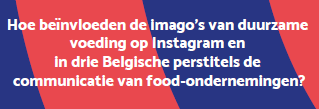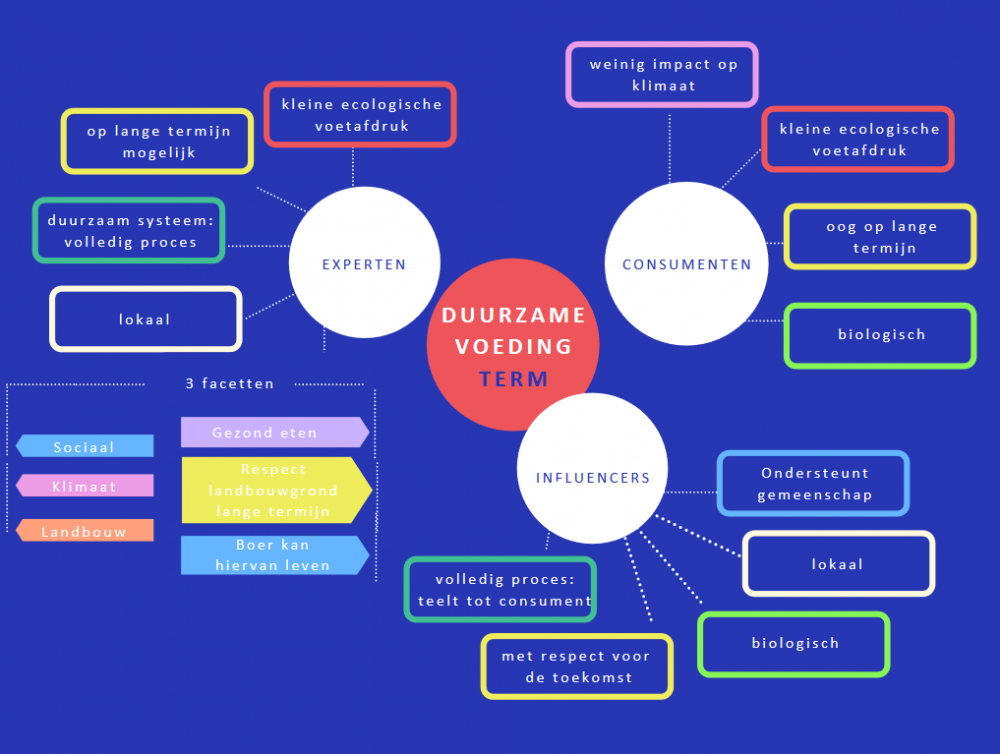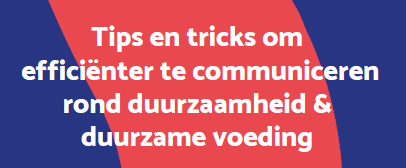8 inzichten over het imago van duurzame voeding en communicatie
Duurzame voeding, moeilijk hé? Wat is dat nu net? Het blijkt een moeilijk onderwerp te zijn om over te communiceren. Via verschillende media worden er diverse imago’s geschetst. Dit maakt de situatie heel complex, zowel voor u, de consument als voor de zender van de communicatie. Want geef toe, als ze in de krant A zeggen, maar uw favoriete influencer zegt B, zal u ook wat verward zijn.
De doelstelling van deze bachelorproef was om enerzijds een duidelijker beeld te schetsen van duurzame voeding en de elementen die eraan verbonden zijn. Anderzijds het van belang van de communicatie via pers en Instagram te analyseren inzake hun efficiëntie en duidelijkheid.
Onderzoeksvraag
Om dit onderzoek zo relevant mogelijk te maken, werd volgende onderzoeksvraag gehanteerd: Hoe beïnvloeden de imago’s van duurzame voeding op Instagram en in de digitale versie van drie Belgische perstitels, de communicatie van food-ondernemingen?
Om deze onderzoeksvraag te kunnen beantwoorden, werden diepte-interviews en inhoudsanalyses uitgevoerd om een antwoord te kunnen bieden. Bij de inhoudsanalyses werd nagegaan wat er in de pers en op Instagram verscheen over het onderwerp.
And the results?
Nadat de resultaten van het kwalitatieve onderzoek en het literatuuronderzoek zijn geanalyseerd, kan een algemene conclusie worden gevormd om een finaal antwoord te geven op de onderzoeksvraag.
Uit het literatuuronderzoek alleen kon de onderzoeksvraag niet worden beantwoord. Het bood wel duiding bij verschillende belangrijke begrippen en concepten; wat nodig was om een succesvol verder onderzoek te garanderen. Duurzame voeding, labelgebruik, maatschappelijk verantwoord ondernemen, influencers, influencermarketing, opinieleiderschap en consumentenbeïnvloeding werden onder andere uitgelegd.
Om tot een volledig antwoord te komen, volgde een kwalitatief onderzoek bestaande uit diepte-interviews en inhoudsanalyses, hierbij werd geanalyseerd wat er in de pers en op Instagram verscheen over duurzame voeding. Tijdens het onderzoek werkten beide onderzoeksmethodes aanvullend: wat werd gezegd in de interviews, werd ook effectief bevestigd in de inhoudsanalyses en omgekeerd. Hieruit kunnen dus verschillende algemene conclusies worden getrokken.
Ja maar, hoe zit het nu concreet?
• Eerst en vooral de term duurzame voeding. De term wordt als een heel complex gegeven gezien met enorm veel facetten en thema’s. Deze veelzijdigheid zorgt ervoor dat men nooit een volledig beeld heeft van wat duurzame voeding precies is.
• Over labelgebruik bestaan er vandaag de dag nog veel twijfels en bedenkingen. Labels kunnen pas dienen als gids voor consumenten wanneer ze er de betekenis van kennen. Als dit niet het geval is, creëert het een extra verwarrende factor voor de consument wat tot twijfel leidt in hun koopgedrag.
• Over duurzame voeding wordt er via pers, influencers op Instagram en websites van bedrijven gecommuniceerd. Geschreven pers en influencers hebben beiden een grote invloed op het consumentengedrag en op het imago van duurzame voeding. Ieder mogelijk kanaal heeft daarentegen wel zijn eigen moeilijkheden.
• Journalisten krijgen steeds vaker het verwijt niet objectief genoeg te zijn, hetgeen een negatief effect heeft op hun geloofwaardigheid. Over duurzame voeding verschijnen er weinig artikels omdat het een onderwerp is met weinig nieuwswaarde.
Wat er over het onderwerp verschijnt in de geselecteerde kranten is neutraalpositief, vooral als het over lokale projecten gaat.
• Influencers verliezen geloofwaardigheid als er geen doordachte match is tussen het merk en de influencerbrand bij influencermarketing. Op Instagram zijn er allerlei foodies die het onder andere over duurzame voeding hebben. Maar om een geloofwaardige en authentieke boodschap te brengen, moet de influencerselectie zeer doordacht gebeuren. De gemonitorde influencers schreven enkel positieve zaken over duurzame voeding.
• Bedrijven die over hun duurzaamheidsinitiatieven communiceren in het kader van Corporate Social Responsability hebben een negatieve invloed op het imago van duurzame voeding. Door enkel over de positieve zaken te communiceren, komt deze informatie niet oprecht over. Hierdoor worden de twijfels rond duurzame voeding enkel in de hand gewerkt. Vaak zijn deze gegevens ook moeilijk te vinden op hun websites.
• Afhankelijk van de doelgroep die men viseert, kan men de gewenste opinieleider selecteren om de communicatieboodschap over te brengen. Voor de consumenten primeert de zender van de informatie of communicatie boven het medium waarlangs dit gebeurt. Hierdoor moet er een weloverwogen keuze worden gemaakt.
Welke journalist de informatie krijgt toegestuurd of met welke influencer er wordt samengewerkt, bepaalt het slagen van je communicatie.
• Het allerbelangrijkste van gelijk welke communicatie omtrent duurzame voeding is transparant communiceren. De consumenten hebben nood aan een eerlijk en transparant verhaal, enkel zo kan op lange termijn een vertrouwensband worden opgebouwd.
In deze 8 punten, kun je de algemene inzichten van deze bachelorproef samenvatten. Met deze nieuwe kennis, werd in het kader van deze bachelorproef ook een communicatiehandleiding uitgewerkt. Op deze manier hebben (communicatie)bedrijven een concrete oplossing voor het communicatieprobleem dat bestaat!
Ga jij vanaf nu anders kijken naar duurzame voeding en de communicatie errond?
Bibliografie
Allué, T. (2013). Food sector communication and online influencers. Catalan Journal of Communication & Cultural Studies, 5(2), 311–314. https://doi.org/10.1386/cjcs.5.2.311_1
Antonides, G., & Raaij, W. F. van. (2002). Consumentengedrag. Geraadpleegd van https://research.wur.nl/en/publications/consumentengedrag-2
Avermaete, T., Keulemans, W., Claes, J., De Tavernier, J., Geeraerd, A., Govers, G., … Vanpaemel, G. (2017). Wat met ons voedsel? Lannoo Campus; Leuven.
Bakker, F. de, & Nijhof, A. (2002). Responsible chain management: A capability assessment framework. Business Strategy and the Environment, 11(1), 63–75. https://doi.org/10.1002/bse.319
Bandura, A. (2001). Social Cognitive Theory: An Agentic Perspective. Annual Review of Psychology, 52(1), 1–26. https://doi.org/10.1146/annurev.psych.52.1.1
Bloglovin’. (2017). We asked they answered: How marketers are leveraging influencer marketing | Bloglovin’ Marketers Survey 2017. Bloglovin’.
Brandwatch. (2016). How to Understand and Influence Consumer Behavior [Brandwatch]. Geraadpleegd 12 februari 2020, van Brandwatch website: https://www.brandwatch.com/blog/how-understand-influence-consumer-behav…
Bruns, A. (2015). Making Sense of Society Through Social Media. Social Media + Society, 1(1), 2056305115578679. https://doi.org/10.1177/2056305115578679
Carey, J. R., Clicque, S. H., Leighton, B. A., & Milton, F. (1976). A Test of Positive Reinforcement of Customers. Journal of Marketing, 40(4), 98–100. https://doi.org/10.2307/1251075
Carrington, M. J., Neville, B. A., & Whitwell, G. J. (2010). Why Ethical Consumers Don’t Walk Their Talk: Towards a Framework for Understanding the Gap Between the Ethical Purchase Intentions and Actual Buying Behaviour of Ethically Minded Consumers. Journal of Business Ethics, 97(1), 139–158. https://doi.org/10.1007/s10551-010-0501-6
Casaló, L. V., Flavián, C., & Ibáñez-Sánchez, S. (2017). Understanding Consumer Interaction on Instagram: The Role of Satisfaction, Hedonism, and Content Characteristics. Cyberpsychology, Behavior, and Social Networking, 20(6), 369–375. https://doi.org/10.1089/cyber.2016.0360
Casaló, L. V., Flavián, C., & Ibáñez-Sánchez, S. (2018). Influencers on Instagram: Antecedents and consequences of opinion leadership. Journal of Business Research, 10.
Cho, Y.-N., & Baskin, E. (2018). It’s a match when green meets healthy in sustainability labeling. Journal of Business Research, 86, 119–129. https://doi.org/10.1016/j.jbusres.2018.01.050
Cowden, A. (2014). Effect of Social Media Marketing on Traditional Marketing Campaigns in Young Icelandic Companies. Reykjavík University School of Business, Iceland.
Creighton, J. L., Foster, J. W., Klingsmith, L., & Withey, D. K. (2013). I just look it up: Undergraduate student perception of social media use in their academic success. The Journal of Social Media in Society, 2(2). Geraadpleegd van https://www.thejsms.org/tsmri/index.php/TSMRI/article/view/48
Debergh, R., Willems, J., Vaes, R., Vandermersch, F., Coene, I., Keldermans, M., … Vanhaverbeke, L. (2019). Naar een duurzamezuivelsector in Europa. De rol van zuivel binnen een gezond en duurzaam voedingspatroon. (pp. 10–11). VLAM.
Digital Canteen. (2019, maart 7). Is There A Difference Between WOM And Influencer Marketing? Geraadpleegd 15 februari 2020, van Digital Canteen website: https://digitalcanteen.com.au/blog/difference-between-wom-and-influence…
Dutta, S., Lawson, R., & Marcinko, D. (2012). Paradigms for Sustainable Development: Implications of Management Theory. Corporate Social Responsibility and Environmental Management, 19. https://doi.org/10.1002/csr.259
East, R., Singh, J., Wright, M., & Vanhuele, M. (2016). Consumer Behaviour: Applications in Marketing. SAGE.
Ecolabel Index | Who’s deciding what’s green? (z.d.). Geraadpleegd 11 januari 2020, van http://www.ecolabelindex.com/
Evans, L., & Saker, M. (2017). Location-Based Social Media. https://doi.org/10.1007/978-3-319-49472-2
Exposure. (2018, april 7). Wat is nudging? Wat is nudging? Exposure. Geraadpleegd 13 februari 2020, van Exposure website: https://exposure.be/blog/wat-is-nudging/
Exposure. (2019, juni 23). Nudges om gezonder te eten. Geraadpleegd 13 februari 2020, van Exposure website: https://exposure.be/blog/nudging-gezonder-eten/
FOD Economie. (2019). Maatschappelijk verantwoord ondernemen | FOD Economie. Geraadpleegd 9 februari 2020, van https://economie.fgov.be/nl/themas/ondernemingen/een-onderneming-behere…
Forsyth, R., Morrell, B., Lipworth, W., Kerridge, I., Jordens, C. F. C., & Chapman, S. (2012). Health Journalists’ Perceptions of Their Professional Roles and Responsibilities for
Ensuring the Veracity of Reports of Health Research. Journal of Mass Media Ethics, 27(2), 130–141. https://doi.org/10.1080/08900523.2012.669290
Gorkana News. (2016, januari 22). A guide to influencer marketing. Geraadpleegd 12 februari 2020, van Gorkana website: https://www.gorkana.com/2016/01/a-guide-to-influencer-marketing-on-inst…
Grayson, D., Hodges, A., & Hodges, A. (2017). Corporate Social Opportunity! : Seven Steps to Make Corporate Social Responsibility Work for your Business. https://doi.org/10.4324/9781351280884
Grunert, K. G., Hieke, S., & Wills, J. (2014a). Sustainability labels on food products: Consumer motivation, understanding and use. Food Policy, 44, 177–189. https://doi.org/10.1016/j.foodpol.2013.12.001
Grunert, K. G., Hieke, S., & Wills, J. (2014b). Sustainability labels on food products: Consumer motivation, understanding and use. Food Policy, 44, 177–189. https://doi.org/10.1016/j.foodpol.2013.12.001
Heggde, G., & Shainesh, G. (Red.). (2018). Social media marketing: Emerging concepts and applications. Singapore: Palgrave Macmillan.
Home | Delhaize Ambassadeurs. (2018). Geraadpleegd 13 februari 2020, van https://ambassadeurs.delhaize.be/be-nl/
Horne, R. E. (2009). Limits to labels: The role of eco-labels in the assessment of product sustainability and routes to sustainable consumption. International Journal of Consumer Studies, 33(2), 175–182. https://doi.org/10.1111/j.1470-6431.2009.00752.x
Huey, L. S. (2014). How Instagram Can Be Used as a Tool in Social Network Marketing. Center for Southern New Hampshire University (SNHU).
IMEC. (2019). IMEC | Digimeter | Digitale mediatrends in Vlaanderen.
Instagram Influencer Marketing Is Now A $1.7 Billion Industry. (2017, maart 29). Geraadpleegd 3 februari 2020, van Mediakix website: https://mediakix.com/blog/instagram-influencer-marketing-industry-size-…
Jadhav, M. N. P., Kamble, M. R. S., & Patil, M. B. (z.d.). Social Media Marketing: The Next Generation of Business Trends. Social Media Marketing, 5.
Jin, S. V. (2018). Interactive Effects of Instagram Foodies’ Hashtagged #Foodporn and Peer Users’ Eating Disorder on Eating Intention, Envy, Parasocial Interaction, and Online Friendship. Cyberpsychology, Behavior, and Social Networking, 21(3), 157–167. https://doi.org/10.1089/cyber.2017.0476
Keulemans, W., & Avermaete, T. (2017). Commissieverslag: Bespreken boek “Wat met ons voedsel?” in relatie met het Vlaams Parlement. (p. 13). Commissie voor Landbouw, Visserij en Plattelandsbeleid.
Koo, D.-W. (2018). The Impact of Risk Perceptions of Food Ingredients on the Restaurant Industry: Focused on the Moderating Role of Corporate Social Responsibility. Sustainability, 10(9), 3132. https://doi.org/10.3390/su10093132
Kwak, H., Lee, C., Park, H., & Moon, S. (2010). What is Twitter, a social network or a news media? Proceedings of the 19th international conference on World wide web, 591–600. https://doi.org/10.1145/1772690.1772751
Labelinfo | Labelinfo. (z.d.). Geraadpleegd 11 januari 2020, van https://www.labelinfo.be/nl#search//44
Lamarque, C. (2017). Influencers: Wie zijn ze? Waar vind je hen? En hoe ontsteken ze de vlam? Lannoo Meulenhoff - Belgium.
Lee, E., Lee, J.-A., Moon, J. H., & Sung, Y. (2015). Pictures Speak Louder than Words: Motivations for Using Instagram. Cyberpsychology, Behavior, and Social Networking, 18(9), 552–556. https://doi.org/10.1089/cyber.2015.0157
Lehner, M., Mont, O., & Heiskanen, E. (2016). Nudging – A promising tool for sustainable consumption behaviour? Journal of Cleaner Production, 134, 166–177. https://doi.org/10.1016/j.jclepro.2015.11.086
Lombardi, A., Caracciolo, F., Cembalo, L., Lerro, M., & lombardi, pasquale. (2015). How Does Corporate Social Responsibility in the Food Industry Matter? New Medit, 14, 2–9.
MacKenzie, R., Chapman, S., Barratt, A., & Holding, S. (2007). “The news is [not] all good”: Misrepresentations and inaccuracies in Australian news media reports on prostate cancer screening. Medical Journal of Australia, 187(9), 507–510. https://doi.org/10.5694/j.1326-5377.2007.tb01391.x
Mangold, W. G., & Faulds, D. J. (2009). Social media: The new hybrid element of the promotion mix. Business Horizons, 52(4), 357–365. https://doi.org/10.1016/j.bushor.2009.03.002
McCracken, G. (1989). Who Is the Celebrity Endorser? Cultural Foundations of the Endorsement Process. Journal of Consumer Research, 16(3), 310–321. https://doi.org/10.1086/209217
Messaris, P. (1997). Visual Persuasion: The Role of Images in Advertising. SAGE.
Moon, S.-J., Costello, J. P., & Koo, D.-M. (2017). The impact of consumer confusion from eco-labels on negative WOM, distrust, and dissatisfaction. International Journal of Advertising, 36(2), 246–271. https://doi.org/10.1080/02650487.2016.1158223
Moynihan, R., Bero, L., Ross-Degnan, D., Henry, D., Lee, K., Watkins, J., … Soumerai, S. B. (2000). Coverage by the News Media of the Benefits and Risks of Medications. New England Journal of Medicine, 342(22), 1645–1650. https://doi.org/10.1056/NEJM200006013422206
Nederstigt, & Poiezs. (2014). Consumentengedrag. Geraadpleegd van https://www.managementboek.nl/boek/9789001782535/consumentengedrag-a-t-…
Nilsson, M., Griggs, D., & Visbeck, M. (2016). Policy: Map the interactions between Sustainable Development Goals. Nature, 534(7607), 320–322. https://doi.org/10.1038/534320a
Nutri-Score België. (z.d.). Geraadpleegd van https://www.health.belgium.be/sites/default/files/uploads/fields/fpshea…
Olaerts, E. (2019, oktober 24). Onderwerp bachelorproef.
OpenVLD. (z.d.). Nutri-score België. Geraadpleegd 13 februari 2020, van Maggie De Block website: https://www.maggiedeblock.be/tag/nutriscore/
Papacharissi, Z. (2015). We Have Always Been Social: Social Media + Society. https://doi.org/10.1177/2056305115581185
Pelsmacker, P. D., Driesen, L., & Rayp, G. (2005). Do Consumers Care about Ethics? Willingness to Pay for Fair-Trade Coffee. Journal of Consumer Affairs, 39(2), 363–385. https://doi.org/10.1111/j.1745-6606.2005.00019.x
Peters, S., Valkenburg, J., & Veen, J. (2019). Verduurzamende voedseltransities: Alles moet kloppen. 2019, 28–30.
Santé Publique France. (z.d.). Nutri-Score France. Geraadpleegd 13 februari 2020, van /determinants-de-sante/nutrition-et-activite-physique/articles/nutri-score
Schyns, P. (2016). Kiezen bij de kassa. Een verkenning van maatschappelijk bewust consumeren in Nederland. Den Haag: Sociaal en Cultureel Planbureau.
Skinner, B. (1948). Skinner—Operant Conditioning. Geraadpleegd van https://www.academia.edu/23759303/Skinner_-_Operant_Conditioning
Sloan, L., & Quan-Haase, A. (2017). The SAGE Handbook of Social Media Research Methods. SAGE.
There’s now an official guide for social media influencers posting adverts | The Independent. (z.d.). Geraadpleegd 3 februari 2020, van https://www.independent.co.uk/life-style/social-media-influencers-adver…
Thøgersen, J., Haugaard, P., & Olesen, A. (2010). Consumer responses to ecolabels. European Journal of Marketing, 44(11/12), 1787–1810. https://doi.org/10.1108/03090561011079882
Traackr. (2019). The many faces of Influence. Geraadpleegd van https://www2.traackr.com/e/74452/he-Many-Faces-Of-Influence-pdf/ncly6k/…
United Nations. (2019). About the Sustainable Development Goals. Geraadpleegd 28 januari 2020, van United Nations Sustainable Development website: https://www.un.org/sustainabledevelopment/sustainable-development-goals/
Valente, T. W., & Pumpuang, P. (2007). Identifying Opinion Leaders to Promote Behavior Change. Health Education & Behavior, 34(6), 881–896. https://doi.org/10.1177/1090198106297855
Valkeneers, G. (2015). Consumentenpsychologie. De basis. Acco; Leuven.
Van Burken. (2011, juli 6). Implementatie intenties helpen de patiënt zijn doelen te halen. Geraadpleegd 11 februari 2020, van Psychfysio Opleidingen website: https://www.psychfysio.nl/5_10_3/
Van Leuven, S., Joye, S., & Flamey, H. (2015). Bronnengebruik in Vlaamse nieuwsmedia: Een kwantitatieve en kwalitatieve analyse. 1–110.
Vandamme, L. (2019). Community Relations: Duurzaam ondernemen.
Vandenbroele, J., Vermeir, I., Geuens, M., Slabbinck, H., & Kerckhove, A. V. (2020). Nudging to get our food choices on a sustainable track. Proceedings of the Nutrition Society, 79(1), 133–146. https://doi.org/10.1017/S0029665119000971
Varadarajan, R. (2017). Innovating for sustainability: A framework for sustainable innovations and a model of sustainable innovations orientation. Journal of the Academy of Marketing Science, 45(1), 14–36. https://doi.org/10.1007/s11747-015-0461-6
Warde, A., & Gronow, J. (2001). Ordinary consumption. Geraadpleegd van https://trove.nla.gov.au/version/45465585









